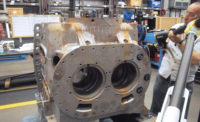Advances in optical design make today’s video measurement systems faster, highly accurate, and far more capable.
Video measurement is a technology used by manufacturers to verify the quality of features on manufactured parts that they make. Video measurement is quantitative. Video inspection is qualitative. Although measuring systems designed for video measurement evolved from optical comparators and from efforts to automate a toolmaker’s microscope, new computers and software, modern illumination techniques, and advances in optical design make today’s video measurement systems faster, highly accurate, and far more capable.
Optical comparators/contour projectors/shadowgraphs have had essentially the same fundamental design since the 1940s. They illuminate a part from behind and magnify its image so its edges are in focus and can be inspected. Lenses can be calibrated so the magnified image scale is accurate enough to perform measurements of widths, diameters, radii, and other characteristics of the part that appears on the comparator screen as a shadow of the part itself.
Beginning in 1956 optical comparators became capable of automatically detecting the position of edges in the magnified image. The part is moved so an edge passes by a detector which senses the change in signal level from the dark shadow to the lighted background or vice versa. The position of the stage when a point is registered is captured so subsequent points from other edges can be used for dimensional measuring.
With that fundamental concept in mind, video measuring systems do the same thing—and much more. At a very basic level a video measuring machine simply replaces the human eye looking at a glass screen of an optical comparator with a camera that images the part on a monitor instead. This seemingly simple change allows significantly more automation for measuring the part.
Since the cameras used for video measurement are made up of numerous pixels, each of those pixels can act like that single edge detector in the comparator example. And they can do so simultaneously. This single difference is a fundamental advantage of video measurement. Because the camera is capable of providing signals from each of its pixels, the video measuring system can find multiple edge points from the entire image. This provides an obvious speed advantage over the comparator with single point edge detection where each edge point has to pass by the fixed detector position. The camera-based video system processes the entire scene in the image while the part is in a fixed position. Some modern systems can actually perform measurements while the stages are moving the part. The measuring software synchronizes the speed of image processing and stage motion so that there is no need to stop the stage to measure—maximizing measurement throughput.
Video measurement is also good for measuring edges that do not cast a shadow when lit from behind, which opens up this technology to parts of all shapes, sizes, and materials constrained only by the need to fit on the measuring machine and contain features that can be seen by the camera. It’s this capability that makes video measurement so popular for a wide range of applications across numerous industries.
Simple examples of edges that cannot be illuminated from behind include slots milled into a block of material or blind holes. You can see these edges with your eye so a video measuring system camera can as well. Lighting from the proper angle can optimize the image of these edges to gather points, the positions of which are known by the system software which combines the encoder/scale position information for the camera scene with the pixel locations within the scene going so far as to use algorithms to identify edge position to fractions of the size of the individual camera pixels. This process is easily automated so that, when part of a computer numerical control (CNC) part measurement routine, the illumination changes and measurement of every individual feature can be done in seconds.
Video Edges are not CMM Edges
Since the measurements are performed to confirm or verify that dimensions match the design drawing, there are some considerations to take into account for how a video measurement of surfaces and edges differs from how those same features are measured by a CMM with a touch probe. Video measurement measures edges directly. An edge exists where there is a transition in the scene imaged on the camera at a boundary between areas where there are changes in characteristics like intensity, color or roughness across the boundary. Back to the slot and blind hole examples, a touch probe CMM cannot measure edges directly. Instead points are taken from the surfaces that intersect at what is seen as an edge. This difference has implications when comparing the measurements of those edges against the design drawing.
In the simplest case an edge of a 3-D part is formed by the intersection of two planes. If those planes are perfectly flat the resulting edge is a straight line. Video measurement of that edge should match the CMM measurement. Differences can occur when one of those planes is not actually planar. Probing a handful of points on that “plane” and fitting those points to a plane in software, then intersecting that calculated plane with the other plane measured in the same way will result in a straight line (edge). However direct video measurement of the line (edge) formed when two intersecting planes are not perfectly flat will provide a different result than the CMM. This difference can exist even in cases where such an edge appears to the eye to be a straight line because video measurement is performed on the magnified image of the edge. A video measurement of such an edge will factor the waviness into the feature size and location calculation. On the other hand, a simple CMM measuring only a few data points with lower resolution will calculate the edge locations differently and necessarily provide a different result. In such a case, video offers the advantage that numerous points are collected simultaneously to form a feature, rather than the feature calculation being the result of many separate point-by-point measurements of surfaces that are then intersected to form that edge (line).
An easier comparison of the technologies is measuring the diameter of a hole in a block of material. The circle where the cylinder meets the top plane can be measured directly with video. That same circle can be calculated by probing the walls of the cylinder, fitting those points to a cylinder, probing the top plane, fitting that surface to a plane, then intersecting the two to then measure the resulting circle. Not only is video measurement much faster, if the hole is small it may not even be possible to get a probe into it, while video would have no problem.
In recent years attempts have been made to add video measurement capabilities to CMMs. Emphasis on such designs has been on illumination and imaging from a sensor mounted in place of the traditional touch probe. One immediate limitation of such a design is the lack of back lighting of the part. All the video measurements are based on surface illumination only. This coupled with performance factors related to the stability of the machine when acquiring magnified video images provides significant limitations. In other words, a CMM accessory does not a video measuring machine make.
Optical Comparators with Video Measurement
In what might be considered ironic as video measuring machines evolved from their optical comparator roots, there are new video measuring technologies available for optical comparators. One such implementation is the video comparator where the traditional glass screen is replaced by a video monitor which shows an image captured on a camera in the comparator. People familiar with video machines and comparators might consider a horizontal video projector as a video measuring machine laid on its back. Because a camera and monitor are used in video comparators they are capable of more measurements than are possible with traditional comparators including the aforementioned acquisition of numerous edge points simultaneously.
Another variant on the optical comparator/video measuring machine hybrid is a video “probe” used in place of one of the magnification lenses in a traditional optical comparator. In this case, the optical comparator functions as always with its traditional glass screen showing the projected image. However, when the video probe is switched into place, it presents the magnified camera image on a video monitor where video measurements are possible like a video measuring machine.
Video measuring is an accepted technology for manufacturing quality control. It co-exists with optical comparators and tool maker’s microscopes as noncontact methods of performing dimensional measurement of magnified images of parts for verification of design specifications. Modern cameras, software, optics and computers bring ever more powerful capabilities to these popular products.
TECH TIPS
|



